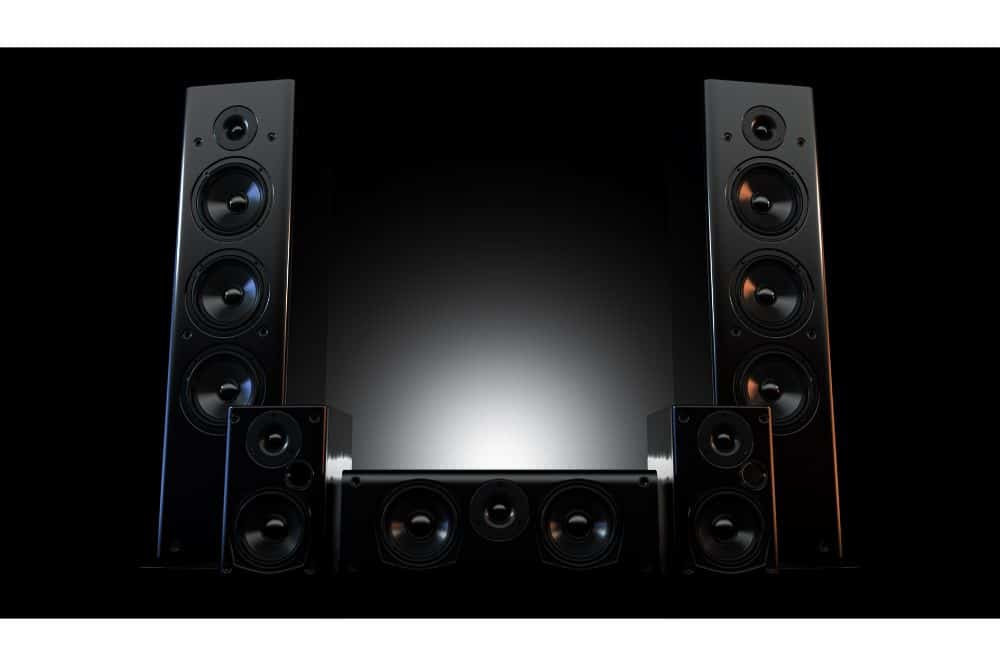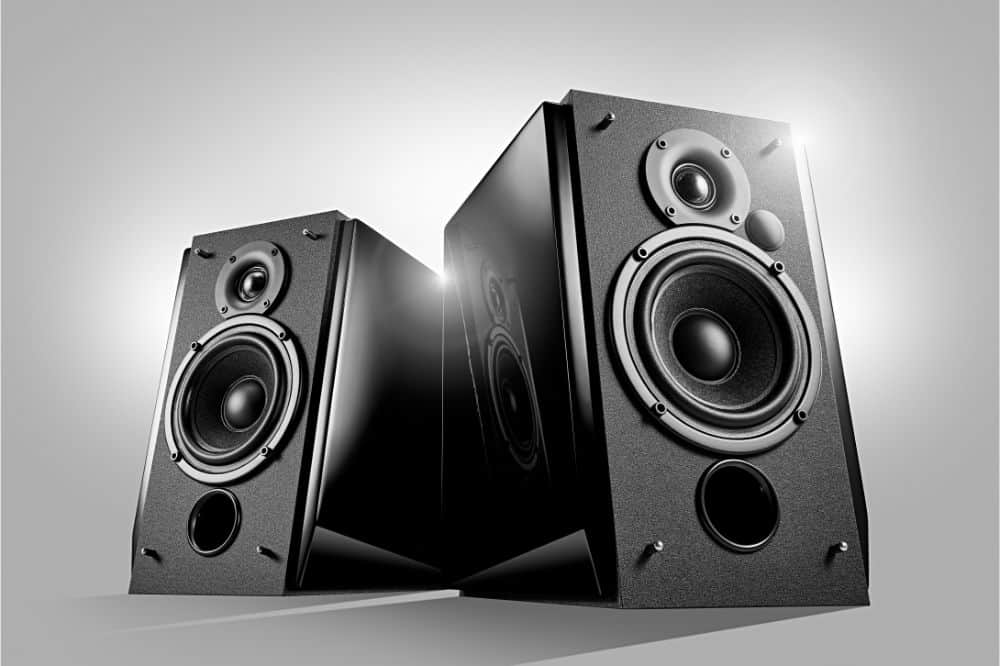When setting up a sound system for the first time, you may have to choose between powered speakers, passive speakers, or a combination of both. It can be challenging because not all vendors and experts agree on which of the two is better.
Fortunately for you, we can help you make the right choice by listing the pros and cons of powered vs passive speakers.
Choosing the Right Speakers
Speakers are essential for any home entertainment system, as audiophiles are aware. Choosing and combining the audio system’s components are likely the most crucial aspects of producing the best sound. When other audiophiles come by for some aural sampling, these aspects are unquestionably the first characteristics observed.
Like all electronics, speakers come in many shapes and sizes, and the features that come with them also vary. Of course, prices also fall under a broad spectrum, depending on every device’s capabilities.
To choose the right speakers for your setup, you must first learn which features are the most important and how much you’re willing to spend.
Suppose you’ve already prepared a budget, measured space allocations, chosen appropriate positioning or mounting, and decided whether to get a bi-wired or single-wired system. The finality of your options will include a battle between active, passive, and powered speakers.
Powered Vs Passive Speakers
If you want to set up an astounding high-fidelity sound system, you ought to know the differences between powered vs passive speakers.
To make things clearer, you even have to understand how active speakers differ from these two.
Since most speakers are passive in design, let’s focus on them first.
What Are Passive Speakers?
Passive speakers are called such because they do nothing to alter incoming signals from a source. This type of speaker leaves this job for the power amplifier. In short, they require an external amplifier to produce the best sound.
The Passive Signal Path
In its simplest form, a traditional stereo high-fidelity system comprises an audio source, a power amplifier, and a set of passive speakers.
Many setups include a preamplifier before the power amplifier to switch between source components and adjust the output volume. The signals travel from the source to the preamp before going to the power amplifier. During this stage, the signals are still line level.
The system needs something to increase or power up the line-level signals to drive a pair of speakers. Here is where the power amplifier comes into play.
However, the power amplifier does not connect directly to the speakers’ drive units. The power amplifier’s output must go through a filtering crossover network that splits the signal’s components.
Two-Way or Three-Way Speakers
The crossover network splits the signal into high and low frequencies if you have two-way speakers. While the high frequencies go to the speakers’ tweeters, the low frequencies travel to the midrange or bass drive units.
Similarly, the crossover network breaks the signals to bass, midrange, and treble if you have three-way speakers.
Regardless of the types of speaker, this crossover network does not require a power source. For this reason, such a setup is always passive.
What Are Active Speakers?
On the other hand, active speakers modify signals actively through amplification. Simply put, the speakers have an internal amplifier.
Unlike passive units that usually come in pairs, active models can come as single speakers.
The Active Signal Path
In an active signal path, everything is pretty much the same as the passive signal path until preamplification. However, as the signals leave the preamp stage, they enter an active crossover network before power amplification.
The active crossover network does the same job as a passive crossover, but it splits the signals at line level instead of at speaker level. Since the power amplifiers work on breaking the signals at lower levels, the system can optimize the sound with more precision.
The filter network is significantly more accurate operationally. As a result, both high and low-frequency sounds benefit from power amplification, making outputs more optimized and integrated.

What Are Powered Speakers?
You’ve probably come across experts and audiophiles saying that all active speakers are essentially powered variants. However, bear in mind that not all powered speakers use the active signal path.
All active speakers are powered because they have a built-in power amplifier that receives all active crossover signals. On the other hand, we cannot consider many powered speakers active because they use the exact signal path a passive setup does.
The only difference is that the preamp and power amp stages are already built into one of the speaker enclosures.
The unit carrying the amplifiers is called the main or master. We call the other speaker the slave because it only works using signals from the amplifier built into the master. This setup becomes pretty apparent when you see a second speaker hardwired or requiring a signal connection to the one receiving signals from a source.
As long as the crossover filtration occurs after amplification, a setup cannot be considered active. Many often mistake a set of powered speakers as active just because they don’t require an external amplifier.
Pros and Cons Roundup
Now that you know the differences between passive, active, and powered speakers, it’s time to look at each type’s highs and lows. This roundup of pros and cons can help you decide the best arrangement for your setup.
Passive Speaker Advantages
Probably the most noticeable advantage of passive models is their simplicity when it comes to power and signal distribution. Since the power only runs to the amplifiers, you only need to lay signal cables to each speaker. This simple setup can help you save time and effort every time you have to prepare your sound system for a gig or event.
The second advantage of passive speaker systems is the easy processing and control implementation of sound outputs. You only have to tweak minimal to zero settings on every passive speaker, and you can make all the adjustments from a single amplifier rack.
The good thing with modern amplifiers is that many now have built-in systems for loudspeaker control, factory presets, and customizable settings. As long as you set up the entire system correctly, you can have a home base for setting optimization adjustments. You can use an amplifier’s presets, create your own, and save them for future use.
Passive Speaker Disadvantages
Obviously, one major drawback of using passive speakers is that they always need power from an external amplifier. Furthermore, each amplifier can only power up to a certain number of passive speakers depending on its wattage.
If you have several main speakers, passive subwoofers, and monitors, you’ll definitely need to stack several amplifiers into a single rack. Basically, the more passive speakers you have, the more amplifiers you need.
In connection with amplifier quantity, there can be significant problems when daisy-chaining several passive speakers. The more passive speaker you daisy-chain can diminish speaker sound output and quality.
Also, since processing and control implementation courses through the amplifiers and mixers, note that you might need better amplifiers for better sound optimization.
Other issues with passive setups include the larger space requirement and reduced portability. Amplifiers take up a lot of rack space, floor space, and cargo space. If you plan on setting up a lights and sounds company, you might want to consider building your arsenal with both passive and active setups.
Active Speaker Advantages
In contrast to passive setups, active speakers do not require you to purchase or transport amplifiers and additional components. Unlike passive speakers, active speakers have the capability to daisy-chain limitlessly for a wide coverage area.
There are active subwoofers and monitors that are much like their passive counterparts, but they have a built-in amplifier.
Secondly, since active speakers only use a low current draw, you can easily set up and run several on a low-amp circuit.
Another advantage of an active system is that it offers better sound quality through built-in sound optimization in each speaker unit. You can optimize individual components of the speakers through the active crossover network.
Finally, modern active speakers now have built-in presets provided by the manufacturers. These features can result in more consistent sound quality even when used across multiple events.
Active Speaker Disadvantages
However, every speaker with a built-in amplifier requires its own external power source. As such, you will have to run a power outlet or extension cord to every unit along with the audio signal cables.
While active speakers open up more space otherwise occupied by amplifiers, they will definitely require more storage, organizers, and runners for more cables.
Another problem arises when daisy-chained active speakers are paired with noise-rejecting mics that use twisted quad-cables. These quad-cables increase capacitance in the system, converting the links into a low-pass filter. This issue becomes evident as the filter cuts high frequencies from the signals.
Compared to passive speakers that don’t have a built-in amplifier, an active speaker becomes useless when the built-in amp module becomes damaged. Unless you have a replacement amp module for the unit, you’ll have to replace it entirely.
Powered Speaker Advantages
When choosing powered speakers using a passive crossover setup, you’ll simplify or even remove the problems related to active and passive speakers.
Powered passive setups are usually compact and more affordable, and they are the best option for home and personal applications. They eliminate the need for an external amp and remove the necessity for extra power supply and signal cables. All you have to do is plug the pair into a wall outlet and start listening to sounds.
Powered Speaker Disadvantages
With powered passive setups, however, daisy-chaining becomes limited to the presence of a mixer that can connect to several outputs.
Furthermore, control and optimization are stringent on the capabilities of the built-in preamp and power amp modules.
Active Vs. Passive Speakers
Since powered speakers come in both active and passive designs, the real question is whether to build a passive or an active setup.
Powered speakers are more of a crossover between the two, which is why they offer the most convenience.
Although the final decision is yours, powered speakers are the most common kind found in houses nowadays. These speakers are comprehensive and small, maximizing multiple frequency channels.
With all the pros and cons stated above, you might find it simpler to choose between a traditional passive setup or a simplified powered arrangement.

